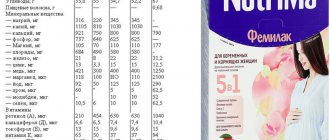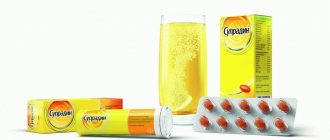Composition, action and release forms
The active components of the supplement are vitamins B1 (thiamine hydrochloride), B6 (pyridoxine hydrochloride), B12 (cyanocobalamin).
Organic compounds regulate protein, lipid and carbohydrate metabolism. The presence or absence of these substances in the human body determines the functional state of the nervous system.
The drug allows you to compensate for the lack of vitamins if the patient is malnourished or sick.
Neurorubin can be purchased at the pharmacy in two dosage forms:
- film-coated tablets;
- injection.
Drug interactions Neurorubin
Because pyridoxine hydrochloride stimulates the decarboxylation of L-dopamine (levodopa) and may reduce the therapeutic effect of this drug in the treatment of patients with Parkinson's disease, the simultaneous use of these drugs should be avoided. The toxicity of isoniazid may increase when used in combination. Thiosemicarbazone and fluorouracil reduce the effectiveness of vitamin B1, being its antagonists. Antacids slow down the absorption of vitamin B1. Vitamin B6 may reduce the effectiveness of altretamine.
In what cases is it used?
High doses of B1, B6, B12 have an analgesic effect. The drug is used for pain caused by acute and chronic neuritis, neuralgia, and damage to the nervous tissue due to the action of toxins. In acute conditions, combination therapy is effective: Neurorubin + NSAIDs, in particular products containing diclofenac.
The drug is also prescribed as a dietary supplement if the patient is unable to ensure sufficient vitamin intake from food.
For what diseases is it used:
- neuralgia of the facial and trigeminal nerves;
- sciatica;
- radicular neuritis;
- intercostal neuralgia;
- plexitis;
- lumbago, etc.
The vitamin preparation is effective in preventing relapses of diseases.
The medicine is also prescribed to patients with emotional instability caused by exposure to stressful circumstances.
Due to insufficient clinical data, the drug is not prescribed to children under 16 years of age.
Neurorubin solution d/in. in amp. 3ml per bl. in pack №5x1
Description
Transparent red solution in brown glass ampoules.
Main active ingredient
Multivitamin
Release form
Solution
Dosage
text
special instructions
Due to the lack of studies regarding drug compatibility, Neurorubin cannot be mixed with other drugs.
Pharmacological properties
Pharmacodynamics
B vitamins are most often part of enzyme systems that regulate the metabolism of proteins, fats and carbohydrates. However, each of the B vitamins performs a specific biological role. Their presence in the body in a balanced amount is necessary for the normal functioning of metabolism. Neurorubin combines high doses of three vitamins: B1, B6, B12, which play an important role in the functioning of the nervous system. Each of these vitamins is necessary to ensure optimal metabolism in nerve cells. In addition, high doses of these vitamins, when used, exhibit an analgesic effect. Neurotropic B vitamins have a beneficial effect on inflammatory and degenerative diseases of the nerves and locomotor system. In large doses, they not only have a substitutive effect, but also have a number of pharmacological effects: analgesic, anti-inflammatory, microcirculatory. Vitamin B1 in the form of thiamine diphosphate and thiamine triphosphate plays a key role in carbohydrate metabolism, being a coenzyme of pyruvate decarboxylase, 2-oxogutarate dehydrogenase and transketolase. In the pentose phosphate cycle, thiamine diphosphate is involved in the transfer of aldehyde groups. Vitamin B6 in its phosphorylated form (pyridoxal-5-phosphate) is a coenzyme of numerous enzymes, primarily involved in the metabolism of amino acids, as well as carbohydrates and fats. Vitamin B12 is essential for cellular metabolism, hematopoiesis and the functioning of the nervous system. It stimulates nucleic metabolism through the activation of folic acid. In large doses, cyanocobalamin has analgesic, anti-inflammatory and microcirculatory effects.
Pharmacokinetics
Water-soluble vitamins are completely absorbed in the body after intramuscular administration. The degree of absorption depends on the location of the bloodstream relative to the injection site. Cyanocobalamin (vitamin B12). After absorption, vitamin B12 binds in serum to specific B12-binding beta (transcobalamin) and B12-binding alpha1 globulin. Vitamin B12 accumulation occurs mainly in the liver. The half-life from serum is approximately 5 days, and from the liver - approximately 1 year. Thiamine hydrochloride (vitamin B1). Part of the absorbed thiamine takes part in the enterohepatic circulation. The main products of thiamine excretion are thiaminecarboxylic acid and pyramine (2,5-dimethyl-4-aminopyrimidine). At the same time, a small amount of thiamine is released unchanged. Pyridoxine hydrochloride (vitamin B6). In the body, pyridoxine is oxidized to pyridoxal or aminated to pyridoxamine. The condition for its functioning as a coenzyme is phosphorylation at the CH2OH group in the 5th position, that is, the formation of pyridoxal-5-phosphate (PALP). In the blood, approximately 80% of PALP is protein bound. Pyridoxine predominantly accumulates in muscles in the form of PALP. The main excretion product is 4-pyridoxic acid. Thiamine is absorbed in the small intestine by active transport. Its absorption is limited to 8-15 mg per day. To prevent vitamin B1 deficiency, its daily replenishment should be 1.3-1.5 mg per day in men, 1.1-1.3 mg in women. Thiamine is excreted in the urine. Pyridoxine, pyridoxal and pyridoxamine are absorbed very quickly and are converted to pyridoxal-5-phosphate. The main metabolite is 4-pyridoxic acid. The required daily amount of vitamin B6 depends on the intensity of protein metabolism; its deficiency is prevented in men with a daily dose of 2.3 mg per day, in women - 2.0 mg. Excreted by the kidneys. Vitamin B12 in the stomach during digestion is released from food and binds to intrinsic factor. The resulting complex is resistant to proteolytic enzymes. Having passed into the distal part of the small intestine, it interacts with specific receptors and then enters the systemic circulation, where it binds to transcobalamin. This complex enters the liver, bone marrow and other proliferating cells, where it is converted into the active form - adenosylcobalamin and methylcobalamin. Vitamin B12 penetrates the placenta. 1.5-3.5 mcg of vitamin B12 is supplied daily with food. If intrinsic factor is deficient, the absorption of vitamin B12 is impaired. The main place of deposition of vitamin B12 is the liver. The half-life is approximately 12 months. It is excreted in bile and, to a lesser extent, in urine.
Indications for use
Neurological disorders caused by a deficiency of vitamins B1, B6, B12, which cannot be eliminated by oral administration of the vitamins included in Neurorubin. Neurorubin is used in adults.
Directions for use and doses
One ampoule is used once a week. The injection is administered deep into the muscle of the upper outer quadrant of the gluteal region, slowly. The duration of treatment depends on the nature and course of the disease and is determined by the doctor. After 4 months of using the drug Neurorubin, the patient should be transferred to oral dosage forms. The drug is administered exclusively intramuscularly. If the drug is accidentally administered intravenously, the patient must be monitored by specialists on an outpatient or inpatient basis, depending on the severity of the symptoms that arise.
Use during pregnancy and lactation
Animal studies of the drug Neurorubin and clinical studies on the use of this drug in women during pregnancy have not been conducted. During pregnancy and breastfeeding, it is recommended to take daily vitamin B1 in a dose of 1.4-1.6 mg per day, vitamin B6 - 2.4-2.6 mg per day. Taking these doses can only be recommended if there is a deficiency of these vitamins. Administration of vitamin B6 in a dose of less than 25 mg per day during pregnancy and breastfeeding is safe. The ampoule contains 100 mg of vitamin B6, so the use of the drug during pregnancy is contraindicated. If it is necessary to use the drug during lactation, breastfeeding should be discontinued. Vitamins B1, B6, and B12 pass from the body into breast milk. High doses of vitamins B6 and B12 can suppress lactation.
Precautionary measures
The drug is administered exclusively intramuscularly. Long-term use of the drug (over 6 months) can cause the development of neuropathy. Intramuscular injections of vitamin B12 may cause anaphylactoid reactions in hypersensitive patients. Children. There is no experience in treating children with this drug, so the drug is not prescribed to children.
Interaction with other drugs
High doses of vitamin B6, such as those contained in Neurorubin, may reduce the therapeutic effect of levodopa on Parkinson's disease. Pyridoxine antagonists, such as isoniazid, cycloserine, penicillamine, hydralazine, may reduce the effectiveness of vitamin B6. Loop diuretics such as furosemide may decrease vitamin B1 concentrations.
Contraindications
The drug is not recommended for use in patients who are sensitive to one or more components, especially vitamins B1, B6, and B12. Children under 18 years of age. Indication of a history of epileptiform seizures.
Compound
active ingredients: 3 ml of solution (1 ampoule) contains: thiamine hydrochloride (vitamin B1) 100 mg, pyridoxine hydrochloride (vitamin B6) 100 mg, cyanocobalamin (vitamin B12) 1 mg; excipients: potassium cyanide 0.25 mg/3 ml, benzyl alcohol, water for injection.
Overdose
Vitamins B1, B6, and B12 have a wide range of therapeutic effects. The phenomena of overdose with proper use have not been known until now. a) Symptoms of intoxication A very high intravenous dose of vitamin B1 (more than 10 g) has a ganglion blocking effect on people and suppresses the transmission of excitation to nerve cells, similar to the action of curare, since thiamine binds to nicotinic cholinergic receptors. The phenomena of hypervitaminosis after taking large amounts of vitamin B1 for a month have not been described before. Vitamin B6, even in doses of 50 mg per day, with medium-term use, can cause severe irreparable neurotoxicosis. Hypervitaminosis, the phenomena of overdose or poisoning of vitamin B12 in humans were not previously known. b) Therapy for intoxication There are no special countermeasures for intoxication; Treatment should be carried out according to symptoms.
Side effect
Side effects are classified by frequency as follows: very often (? 1/10); often (? 1/100 to
Storage conditions
Store at a temperature of 2-8°C (in the refrigerator). Keep out of the reach of children. Shelf life: 3 years.
Buy Neurorubin solution d/in. in amp. 3ml per bl. in pack No. 5x1 in the pharmacy
Price for Neurorubin solution d/in. in amp. 3ml per bl. in pack №5x1
Instructions for use for Neurorubin solution d/in. in amp. 3ml per bl. in pack №5x1
Contraindications for use
The drug is not used if the patient has hypersensitivity to one or more components. Neurorubin is contraindicated in diseases of the hematopoietic system and during exacerbation of peptic ulcer disease.
The supplement is contraindicated in patients with severe or acute heart failure.
The drug is not used to treat patients with neoplasms. An exception may be cases of severe vitamin B12 deficiency and resulting anemia.
The drug is prescribed with caution to patients with a history of peptic ulcer disease, since excess pyridoxine can cause bleeding.
Pregnancy and breastfeeding
Clinical studies of the effect of the supplement on intrauterine development of the fetus have not been conducted.
In medical practice, the appropriateness of therapy during pregnancy is assessed by a doctor. When deciding on a prescription, the specialist must compare the expected health benefits for the expectant mother and the possible danger to the child.
B vitamins are excreted into breast milk. To avoid hypervitaminosis in the baby, feeding is suspended during the course of treatment, especially since pyridoxine inhibits the production of prolactin.
Popular questions about Neurorubin
What are Neurorubin tablets for?
The unique three-component composition of the supplement allows you to compensate for the lack of B vitamins and improve metabolism in nerve cells. High doses of the drug have an analgesic effect for neuralgia and neuritis.
How to inject Neurorubin correctly?
Injections are given intramuscularly. The recommended dose for acute conditions is 1 ampoule per day. As the severity of symptoms weakens, parenteral administration is carried out 1-3 times a week. The price for neurorubin (for one ampoule) is about 60 UAH.
How often to inject Neurorubin?
In acute conditions, the medicine must be administered daily. Then injections are given 1-3 times a week. The recommended course of treatment is 4 weeks.
How to take Neurorubin tablets?
The tablet is swallowed whole and washed down with water. The medicine is taken before or during meals. The recommended daily dose is 1–2 pieces. The average course of treatment is 4 weeks.
Side effects of the drug Neurorubin
Hypersensitivity. In patients with hypersensitivity, angioedema may occur. Allergic reactions are observed quite rarely. In isolated cases and under certain conditions, repeated intramuscular injections of preparations containing vitamin B1 can cause anaphylactic shock in patients with hypersensitivity. In these cases, corticosteroids and antihistamines can be used for treatment. Endocrine system. When taking the drug, the release of prolactin is inhibited. Nervous system. In some cases, a feeling of anxiety arose (in patients with hypersensitivity). When taking high doses of pyridoxine hydrochloride (500 mg/day) over a long period of time, isolated cases of reversible peripheral sensory neuropathy have been reported. The cardiovascular system. Isolated cases of tachycardia, circulatory collapse (in patients with hypersensitivity). Respiratory system. Isolated cases of cyanosis, pulmonary edema (in patients with hypersensitivity). Gastrointestinal organs. Nausea, bleeding from the gastrointestinal tract (in patients with hypersensitivity). Liver and gall bladder. High doses of the drug may lead to increased levels of glutamic oxaloacetic transaminase (SGOT) in the blood plasma. Leather. Reactions with itching and urticaria (in patients with hypersensitivity). High doses of the drug may cause acne. Pyridoxine hydrochloride may cause acne. General symptoms. Sudden sweating, feeling of weakness, dizziness.
Note!
The description of the drug Neurorubin on this page is a simplified author’s version of the apteka911 website, created on the basis of the instructions for use.
Before purchasing or using the drug, you should consult your doctor and read the manufacturer's original instructions (attached to each package of the drug). Information about the drug is provided for informational purposes only and should not be used as a guide to self-medication. Only a doctor can decide to prescribe the drug, as well as determine the dose and methods of its use.





